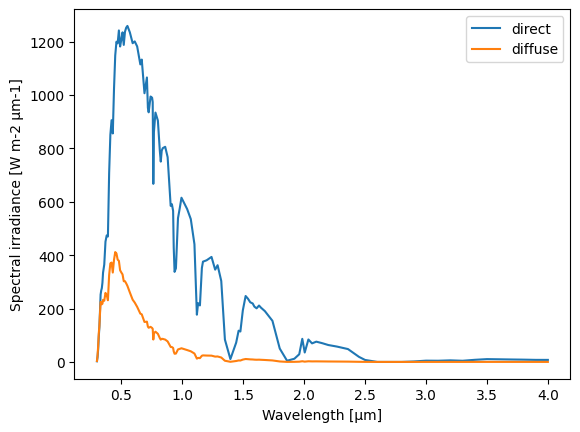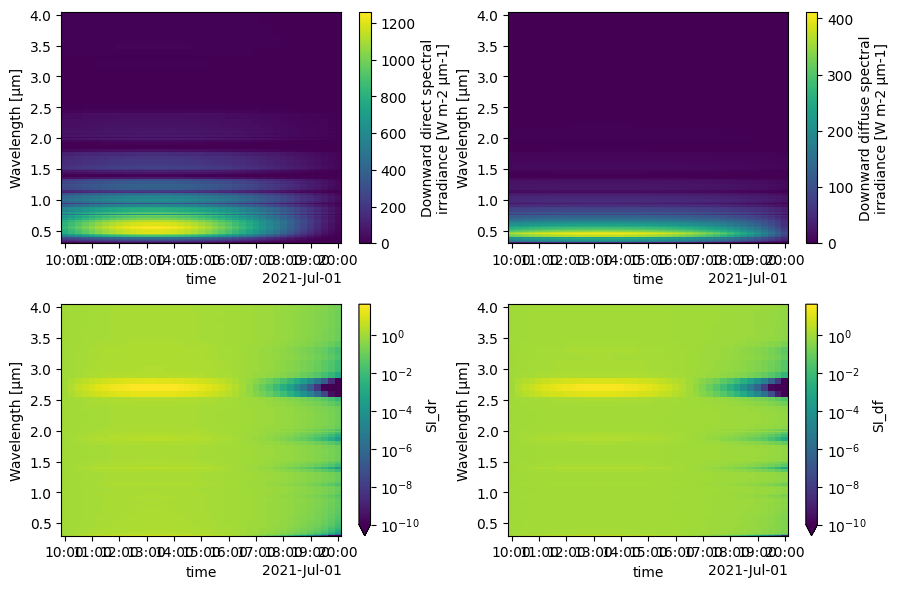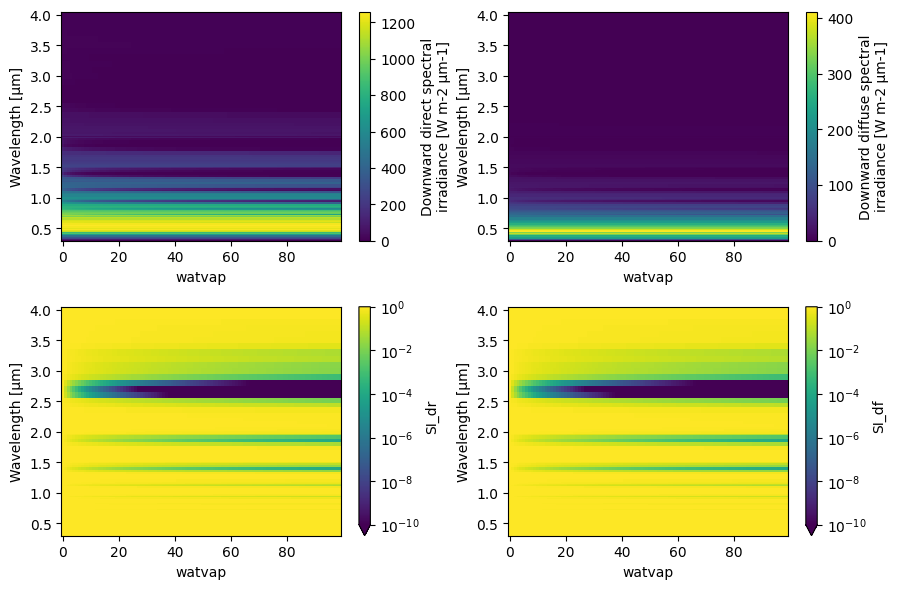External spectra sources#
crt1d comes with some functions that facilitate easy generation of leaf optical property and top-of-canopy irradiance spectra using external programs. These can be found in module crt1d.data.
import matplotlib as mpl
import matplotlib.pyplot as plt
import numpy as np
import pandas as pd
import xarray as xr
import crt1d as crt
SPCTRAL2#
crt1d.data.solar_sp2() runs SPCTRAL2 (via SolarUtils) and saves the results to an xarray.Dataset.
Example#
Walker Building in the summer around local solar noon.
lat = 40.793275995962944
lon = -77.86686570952304
dt0 = pd.Timestamp("2021/07/01 13:00")
utcoffset = -4 # EDT
ds = crt.data.solar_sp2(dt0, lat, lon, utcoffset=utcoffset)
ds
<xarray.Dataset> Size: 2kB
Dimensions: (wl: 122)
Coordinates:
* wl (wl) float32 488B 0.3 0.305 0.31 0.315 0.32 ... 3.6 3.7 3.8 3.9 4.0
Data variables:
SI_dr (wl) float32 488B 2.323 18.16 47.95 95.28 ... 8.518 7.66 7.589
SI_df (wl) float32 488B 3.502 24.66 59.09 ... 0.09369 0.08087 0.07696
SI_et (wl) float32 488B 518.0 539.7 601.3 669.6 ... 10.05 9.183 8.313
sza float64 8B 18.03
saa float64 8B 168.5
inc float64 8B 18.03
time datetime64[ns] 8B 2021-07-01T13:00:00
lat float64 8B 40.79
lon float64 8B -77.87fig, ax = plt.subplots()
ds.SI_dr.plot(ax=ax, label="direct")
ds.SI_df.plot(ax=ax, label="diffuse")
ax.set(ylabel=f"Spectral irradiance [{ds.SI_dr.units}]")
ax.legend();

ds.plot.scatter(x="SI_dr", y="SI_df");

Variations#
Time of day#
dts = pd.date_range("2021/07/01 10:00", "2021/07/01 20:00", freq="15min")
ds = xr.concat(
[crt.data.solar_sp2(dt, lat, lon, utcoffset=utcoffset) for dt in dts],
dim="time"
)
def plot(ds, x=None):
if x is None:
x = list(ds.dims)[0]
fig, axs = plt.subplots(2, 2, figsize=(9, 6))
ax1, ax2, ax3, ax4 = axs.flat
ds.SI_dr.plot(x=x, ax=ax1)
ds.SI_df.plot(x=x, ax=ax2)
norm = mpl.colors.LogNorm(vmin=1e-10)
(ds.SI_dr / ds.SI_dr.isel({x: 0})).plot(x=x, ax=ax3, norm=norm)
(ds.SI_df / ds.SI_df.isel({x: 0})).plot(x=x, ax=ax4, norm=norm)
fig.tight_layout()
plot(ds)

👆 The second row shows how the spectrum shape changes since the first time shown. It seems that, for the most part, the spectrum shape doesn’t change much with time of day on a given day in this model (except around 2.7 μm).
Parameters#
watvaps = np.linspace(0.1, 10., 100)
ds = xr.concat(
[crt.data.solar_sp2(dt0, lat, lon, utcoffset=utcoffset, watvap=watvap) for watvap in watvaps],
dim="watvap"
)
plot(ds)

# TODO: others
PROSPECT-5#
crt1d.data.leaf_ps5() runs PROSPECT-5 (via Python PROSAIL) and saves the results to an xarray.Dataset.
ds = crt.data.leaf_ps5()
ds
<xarray.Dataset> Size: 50kB
Dimensions: (wl: 2101)
Coordinates:
* wl (wl) float64 17kB 0.4 0.401 0.402 0.403 ... 2.497 2.498 2.499 2.5
Data variables:
rl (wl) float64 17kB 0.04099 0.04103 0.04106 ... 0.01878 0.0188
tl (wl) float64 17kB 0.0003881 0.0003982 0.0004079 ... 0.03852 0.0385
n float64 8B 1.2
cab float64 8B 30.0
car float64 8B 10.0
cbr float64 8B 1.0
ewt float64 8B 0.015
lma float64 8B 0.009fig, ax = plt.subplots()
ds.rl.plot(ax=ax, label="reflectance")
ds.tl.plot(ax=ax, label="transmittance")
ax.set(ylabel="")
ax.legend(title="Leaf element");
